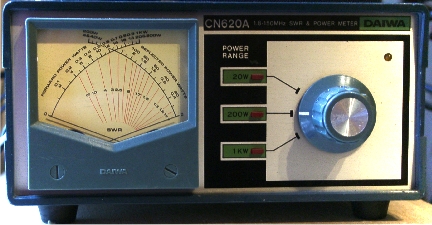



| |
Section 4
Feeders and Antenna
Standing waves
4E1 Recall that the antenna system must be suitable for the frequency of the transmitted signal.
There are various types of antenna that can be used with a transmitter. Whilst an antenna is designed to work on a single frequency, some of the designs can be used as a practical type of antenna for a wide range of single frequencies whilst other cannot and this is all down to physical size constraints. Thus in the 144MHz and 430 MHz band all antennas designs are practical, but when it comes to the HF bands it is a different matter due to their much bigger size.
Elsewhere you may have seen the Frequency to Wavelength conversion chart and this is where it comes into use. For all bands you can think of the most basic antenna as the half wave dipole. This half a wave length is the total overall length of the antenna and thus it has legs each of a quarter wave long. By reference to the chart you will be able to assess what is the full wave length and then divide by 2 to give you a guide as to the over all length of the antenna.
If the antenna is not designed for the particular frequency being the transmitted frequency, then not only will the signal not radiate well but damage could occur to the transmitter and possibly cause EMC problems to next door's TV / radio.
A note of caution.
If you decide to use an antenna analyser to check your antenna do make sure that there is not a near by station transmitting as this will cause false readings on the analyser even though the station is not transmitting necessarily on the same frequency band as the antenna you are making !!!
Recall that if an antenna is not correctly designed for the frequency it will not match the transmitter and will not work effectively.
The aerial has to be the correct physically size for the frequency in use, other wise the radio transmitter will be damaged due to a high SWR, or Standing Wave Ratio Mismatch, and thus will not operate efficiently.
Recall that if the antenna does not match the feeder some power from the transmitter will be reflected back towards the transmitter causing standing waves.
It is the transmitter which could be damaged NOT the antenna. The damage to the transmitter occurs because some of the power is reflected back down the feeder by the antenna to the transmitter causing STANDING WAVES
A Standing Wave, also called a Stationary Wave, is the combination of two waves moving in opposite directions, each having the same amplitude and frequency such as those waves travelling back to a transmitter and are not going into the antenna due to a mismatch.
When out going and returning waves are superimposed, their energies are either added together or cancelled out.
4E2 Recall that an SWR meter shows whether an antenna presents the correct match to the transmitter and is reflecting minimum power back to the transmitter.

"S" "W" "R" stands for Standing Wave Ratio. The picture shows an SWR meter/power meter. Note that this unit has two needles. This is not always the case but here the forward and reflected power are shown simultaneously. Other meters require the operator to switch between forward and reflected power and compare reading to know relatively how much RF is going in each direction. With a high forward power level and a low reflected power level the antenna could be said to be well matched to the operating frequency but is said to be "mis-matched" if the forward is high and the reflected is high. A high SWR can cause damage to your rig, see more in the next section.
Recall that a high SWR, measured at the transmitter, is an indication of a fault in the antenna or feeder and not the transmitter.
It is the SWR meter which is used to measure the SWR (Standing Wave Ratio) on the feeder line.It is an indication of a fault with the antenna and or feeder and not with the Transmitter.
If the aerial is not correctly matched to the transmitter frequency then when a signal travels up the feeder to the aerial it is reflected back to the transmitter and the system is inefficient.
If the ratio of forward to reflected power or "SWR" measured at the transmitter is high then much of the power is being reflected back to the transmitter. This could be the fault of the antenna or some other problem with the feeder such as a broken or incorrectly tightened connector. Thus the fault lies any where but with the transmitter.
With a correctly matched antenna and good feeder only a very small amount if any of the forward power will be reflected back.
A high SWR would also occur if you unwittingly failed to plug the aerial into the transmitter and pressed the PTT if operating AM FM and also SSB and spoke into the microphone.
Recall that the transmitter may be damaged in the presence of a high SWR much greater than 2:1
If the SWR reading is greater than 2:1 then damage to the transmitter may occur and this might result in an expensive repair bill!!
The origin of some of the text on this page is from the RSGB with additions by the web master